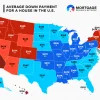Conventional Loan Down Payment Requirements for 2025

Most buyers can get a conventional loan with as little as 3% to 5% down, depending on income and first-time buyer status. Your specific down payment requirement and monthly costs can vary based on home price, property type, and whether you're buying a primary, secondary, or investment home.
Coming up with a down payment is one of the biggest hurdles for many prospective homebuyers. Saving up the cash is even more difficult when you don't know exactly how much you will need. However, figuring it out is pretty straightforward with a conventional loan.
Article Overview
If you're a first-time homebuyer or earn 80% or less of your area's median income, you can get a conventional loan with a down payment of just 3%. Otherwise, you'll need at least 5% down.
A larger down payment will reduce your monthly mortgage payments and the cost of your private mortgage insurance.
With 20% down, you can eliminate PMI altogether.
How Much Do You Have to Put Down for a Conventional Loan?
The average borrower will need a conventional loan down payment between 3% and 5% of their property's purchase price. For example, if you buy a $250,000 home, you’ll need to put down at least $7,500 or $12,500. Additionally, there are many scenarios where your required down payment could be even higher.
The amount you have to put down for a conventional loan depends on your purchase price and the loan program you qualify for.
Here's a chart showing the required down payments at various home values for 3% and 5% down borrowers. We've also included the amount of a 10% and 20% down payment for each price point.
Home Value | 3% Down | 5% Down | 10% Down | 20% Down |
$200,000 | $6,000 | $10,000 | $20,000 | $40,000 |
$250,000 | $7,500 | $12,500 | $25,000 | $50,000 |
$300,000 | $9,000 | $15,000 | $30,000 | $60,000 |
$350,000 | $10,500 | $17,500 | $35,000 | $70,000 |
$400,000 | $12,000 | $20,000 | $40,000 | $80,000 |
$450,000 | $13,500 | $22,500 | $45,000 | $90,000 |
$500,000 | $15,000 | $25,000 | $50,000 | $100,000 |
$550,000 | $16,500 | $27,500 | $55,000 | $110,000 |
$600,000 | $18,000 | $30,000 | $60,000 | $120,000 |
$650,000 | $19,500 | $32,500 | $65,000 | $130,000 |
$700,000 | $21,000 | $35,000 | $70,000 | $140,000 |
$750,000 | $22,500 | $37,500 | $75,000 | $150,000 |
Primary Residences
First-time buyers and those who earn 80% or less of their area's median income are eligible to get a conventional loan on a single-family primary residence with as little as 3% down. Borrowers who do not qualify under these first-time and lower-income programs need 5% down.
When purchasing a $300,000 house, that’s a down payment of either $9,000 (3%) or $15,000 (5%).
Thanks to changes recently implemented by Fannie Mae and Freddie Mac, the down payment requirements for multi-unit primary residences have been drastically reduced. Now, borrowers can get a conventional loan on a two- to four-unit property with just 5% down, provided they plan to live full-time in one of the units.
Second Homes
If you're purchasing a second home or vacation property with a conventional loan, you’ll need at least 10% down. Keep in mind that only single-family properties are eligible for this type of mortgage since conventional guidelines do not allow for multi-unit second homes.
Investment Properties
Conventional borrowers need 15% down to purchase a single-unit investment home. For properties with two to four units, investors must put down 25% of the purchase price.
3% Down Conventional Loan Programs
Conventional loan guidelines allow for a 3% down payment from buyers purchasing their first home and those with incomes well below their area's norm. Here are the 3% down conventional loan programs worth considering.
97% Conventional & HomeOne
Fannie Mae’s 97% Conventional and Freddie Mac’s HomeOne programs are designed to help first-time buyers take the leap into homeownership with just 3% down. Conventional guidelines consider a first-time homebuyer to be anyone who has not owned property within the previous three years.
HomeReady & Home Possible
Lower-income borrowers may be eligible for a 3% down payment under Fannie Mae’s HomeReady or Freddie Mac’s Home Possible loan programs. To qualify, you cannot earn more than 80% of your area’s median income.
Borrowers using these loan types may be eligible for lower interest rates and cheaper mortgage insurance premiums. Plus, very low-earning borrowers who earn 50% or less of their area's median income may qualify for an additional $2,500 credit.
How to Get a Conventional Loan With Zero Down Payment
While most homebuyers will put either 3% or 5% down, getting a conventional loan with zero down payment is possible.
Even though conventional loans have a cap at either 95% or 97% of a property's loan-to-value ratio (LTV), you can borrow as much as 105% through approved down payment assistance (DPA) programs.
DPA options are predominantly localized, with programs commonly offered through state and municipal government agencies and community-based nonprofits.
For example: You're purchasing a $250,000 home and qualify for a 97% conventional mortgage. Your down payment requirement is $7,500. If you receive a Community Second DPA of $15,000, you will end up borrowing $257,500 (a 103% LTV), which covers your home purchase, plus some or all of your closing costs.
Conventional guidelines also allow cash gifts from family members to put toward your down payment and closing costs. You will need some documentation for sourcing the gift, but there is no restriction on the amount you can receive when purchasing a single-family primary residence.
Don’t Forget About Closing Costs
Your down payment is not the only cash you'll be expected to bring to the closing table. You will also need to pay closing costs.
These fees include title research and insurance, lender fees and points, the appraisal, and funding the escrow account. Your actual total depends on various factors, but conventional closing costs are typically between 2% and 4% of the amount financed.
For example: On a $250,000 mortgage, plan for closing costs ranging from $5,000 to $10,000. Your lender will provide you with a loan estimate that discloses all closing fees.
Your Down Payment Affects Your PMI Premium
Lending guidelines require that all conventional borrowers making a down payment of less than 20% pay for private mortgage insurance (PMI). PMI is an insurance policy, typically paid monthly as part of your mortgage payment, that protects your lender from loss if you quit making your payments and default on the loan.
Your credit score has the largest impact on your PMI premium. However, the amount you pay can also vary based on the type of mortgage you choose and the size of your down payment.
In most cases, borrowers who make a 5% down payment will pay lower PMI premiums than those who put 3% down. Similarly, buyers typically pay increasingly less at 10% and 15% down, and PMI isn’t required with 20% or more down.
Although paying PMI of less than $100 per month is possible, buyers with bad credit or those purchasing more expensive homes will pay more.
Down Payment Requirements for Conventional Loan Alternatives
Conventional loans are the most popular type of residential mortgage out there. But they aren't the only option — buyers have a variety of options, some of which allow for zero money down without using down payment assistance programs (although you can still use them if you want).
FHA Loans
FHA loans are designed to allow buyers with credit issues to qualify for a 3.5% down home loan. You can get an FHA loan with a credit score of 580. However, some lenders may be willing to accept borrowers with a score as low as 500 if they can put 10% down.
VA Loans
You typically need to be a veteran, active service member, or eligible spouse to qualify for a 0% down VA loan. VA interest rates are generally lower than comparable conventional mortgages.
VA loans do not require mortgage insurance; however, most borrowers pay a funding fee at closing.
USDA Loans
USDA loans are available for buyers purchasing property in rural or low-density suburban areas. These loans let you buy a home with no money down and a subsidized interest rate. USDA mortgages have a maximum income limit, which varies based on your area and the number of people in your household.
Frequently Asked Questions: Conventional Loan Down Payments
Do You Have to Put 20% Down on a Conventional Loan?
No. This is a long-running myth. While 20% is still an excellent down payment target, it's possible to get conventional loans with as little as 3% down. Just expect to pay for private mortgage insurance until you reach 20% equity.
How Much Down Payment for a Conventional Loan With Bad Credit?
The amount of your conventional loan down payment typically won't change based on your credit. However, conventional lenders will require a minimum credit score of 620 to qualify. Even then, a lower credit score means you’ll be charged higher interest rates.
If you have bad credit, consider an FHA loan, which accepts a score as low as 580 with a 3.5% down payment.
Are Down Payment Requirements Lower for Conventional or FHA Loans?
FHA loans allow all borrowers to purchase a primary residence with up to four units for just 3.5% down. By contrast, conventional loans allow first-time and lower-income homebuyers to purchase a single-family primary residence with just 3% down. All other buyers can expect to need a conventional loan down payment percentage of 5%.
So, if you're purchasing a single-unit home and qualify for one of the 3% down programs, you'll have a lower down payment requirement going conventional. Other buyers will find the FHA down payment requirements lower than the standard 5% conventional minimum.
To explore your conventional down payment options, take a look at today’s mortgage rates and apply with an experienced lender serving your community.






